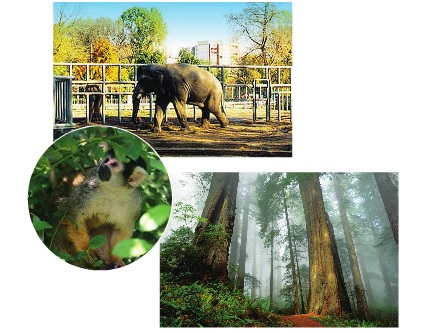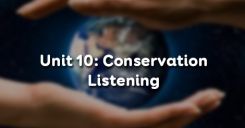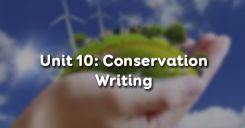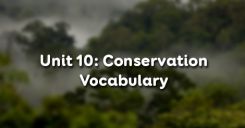Bài học Reading Unit 10 tiếng Anh lớp 10 hướng dẫn các em đọc và tìm hiểu nội dung xoay quanh việc bảo tồn thiên nhiên và động vật hoang dã.
Tóm tắt bài
1. Before You Read Unit 10 Lớp 10
Look at the pictures, and then answer the questions. (Nhìn vào tranh, và sau đó trả lời các câu hỏi.)

1. Have you ever visited a zoo or a forest? (Bạn đã từng thăm sở thú hay một khu rừng chưa?)
2. What animals are you interested in? Why? (Bạn quan tâm đến loài động vật nào? Tại sao?)
3. Do you need to protect animals forests? (Chúng ta có cần bảo vệ động vật và rừng không?)
Guide to answer
1. Yes. I visited a zoo in Ha Noi when I was eleven.
2. I'm interested in wild animals such tigers, lions or brown hears, ... because these animals are at risk of being extinct.
3. Yes. I think we should protect animals and forests, because if we do not, they will disappear in the near future.
2. While You Read Unit 10 Lớp 10
Read the paragraphs, and then do the tasks that follow. (Đọc đoạn văn, và sau đó làm các bài tập theo sau.)
2.1. Unit 10 Reading Task 1
Match the word in A with a suitable definition in B. (Ghép từ ở A với phần định nghĩa phù hợp ở B.)
| A | B |
|
1. eliminate 2. circulation 3. run -off 4. hydroelectric |
a. the movement of something around a closed system b. concerning or producing electricity by the power of falling water c. remove or get rid of completely d. liquid which flows off or from (something) |
Guide to answer
1 - c 2 - a 3 - d 4 - b
eliminate: tiêu diệt, loại bỏ
circulation: vòng tuần hoàn
run-off: chảy xiết
hydroelectric: thủy điện
2.2. Unit 10 Reading Task 2
Decide whether the following statements are true(T) or false (F). (Xác định xem những phát biểu sau là đúng (T) hay sai (F).)
1. Each year about fifty hundred species of plants and animals are eliminated.
2. Many kinds of plants could be used to treat various dangerous diseases.
3. Water can be held on land by vegetation.
4. Man is constantly doing harm to the environment.
5. Plants may cause floods and erosion.
6. We can do nothing to save the earth.
Guide to answer
1. T 2. T 3. T 4. T
5. F => Plants hold water back, so they prevent rapid run-off which can cause floods and erosion.
6. F => We can stop worsing the problem while scientists search for answers, and laws are passed in nature's defense.
2.3. Unit 10 Reading Task 3
Choose the most suitable main idea for each paragraph. (Chọn ý chính thích hợp nhất cho mỗi đoạn văn.)
1. We cannot live without water.
2. Let's do something to save the earth.
3. Forests give us a lot of valuable things.
4. Vegetation can help conserve water.
Guide to answer
A - 3 B - 4 C - 2
A - 3 Forests give us a lot of valuable things. (Rừng đem lại cho chúng ta nhiều thứ quí giá.)
B - 4 Vegetation can help conserve water. (Thảm thực vật có thể giúp bảo tồn nước.)
C - 2 Let's do something to save the earth. (Hãy làm điều gì đó để bảo vệ trái đất.)
3. After You Read Unit 10 Lớp 10
Answer the following questions. (Trả lời các câu hỏi sau.)
1. What is the consequence of losing forest? (Đâu là hậu quả của việc tàn phá rừng?)
2. How important is water in our life? (Nước quan trọng như thế nào trong cuộc sống của chúng ta?)
3. What should we do for the future of our planet? (Chúng ta nên làm gì cho tương lai của hành tinh của chúng ta?)
Guide to answer
1. The consequence of losing forest is destroying the earth's plant and animal variety.
2. Man and most animals need a constant supply of water to live on.
3. We should protect our environment by stopping worsening the problem and by passing laws in nature's defence.
4. Bài dịch Reading Unit 10 Lớp 10
A. Rừng bị tàn phá đang hủy hoại sự đa dạng về động thực vật trên trái đất. Các nhà khoa học cho biết có khoảng 5000 loài động thực vật bị tiêu diệt hàng năm. Điều này đặc biệt đáng lo ngại vì có nhiều loại cây cỏ và động vật có thể được dùng làm thuốc chữa bệnh ung thư, AIDS, bệnh tim và nhiều bệnh khác. Có thể chúng ta chẳng bao giờ biết được cái giá thật sự của sự hủy hoại này.
B. Con người và hầu hết các loài động vật cần có một lượng nước cung cấp thường xuyên để sống. Nông dân cần nước cho mùa màng. Các đập thủy điện giữ lại lượng nước cần thiết để phát điện dùng cho gia đình và các ngành công nghiệp. Cây cỏ và các loại thực vật khác đóng vai trò quan trọng trong vòng tuần hoàn tự nhiên của nước và do vậy chúng giúp bảo tồn nguồn nước. Không có cây cối, phần lớn nước sẽ chảy đi ngay khi nó rơi xuống, cuốn theo lớp đất màu mỡ. Nước chảy xiết sẽ gây ra lũ lụt thường xuyên và hạn hán vào mùa khô.
C. Ngày nay hầu như tất cả báo chí đều đăng tin về việc tàn phá môi trường do chúng ta đang gây ra. Trái đất đang bị đe dọa và tương lai có vẻ tệ hại. Mỗi người trong chúng ta cần phải làm gì? Chúng ta không thể làm sạch sông, biển đã bị ô nhiễm trong một đêm. Chúng ta cũng không thể ngăn chặn sự biến mất của cây cối và động vật. Nhưng chúng ta có thể không làm vấn đề tệ hại thêm trong khi chờ đợi các nhà khoa học tìm kiếm giải pháp và luật bảo vệ thiên nhiên được thông qua.
Bài tập minh họa
Read the passage below carefully, and then choose the best answer:
Conservation conflicts arise when natural-resource shortages develop in the face of steadily increasing demands from a growing human population. Controversy frequently surrounds how a resource should be used, or allocated, and for whom. For example, a river may supply water for agricultural irrigation, habitat for fish, and water-generated electricity for a factory. Farmers, fishers, and industry leaders vie for unrestricted access to this river, but such freedom could destroy the resource, and conservation methods are necessary to protect the river for future use.
Conflicts worsen when a natural resource crosses political boundaries. For example, the headwaters, or source, of a major river may be located in a different country than the country through which the river flows. There is no guarantee that the river source will be protected to accommodate resource needs downstream. In addition, the way in which one natural resource is managed has a direct effect upon other natural resources. Cutting down a forest near a river, for instance, increases erosion, the wearing away of topsoil, and can lead to flooding. Eroded soil and silt cloud the river and adversely affect many organisms such as fish and important aquatic plants that require clean, clear freshwater for survival.
New vocabulary:
- controversy (n.): sự tranh luận, sự tranh cãi
- to allocate (v.): chỉ định; cấp cho; phân phối
- to vie (v.): ganh đua, thi đua
- headwater (n.): thượng nguồn, thượng lưư; (pl.) nước nguồn
- silt (n.): bùn, phù sa; (adj.): đầy bùn
- adverse (adj.): đối nghịch; bất lợi
1/ What does “arise” in line 1 mean?
A. stand up B. sit up C. get up D. spring up
2/ What does “supply” in line 4 mean?
A. cover B. provide C. make up for D. compensate for
3/ What does “methods” in line 7 mean?
A. plans B. orders C. ways D. structures
4/ Which word in the reading means “a promise that something will be done or will happen, especially a written promise by a company to repair or change a product that develops a fault within a particular period of time”?
A. guarantee B. shortage C. population D. habitat
5/ Which word in the reading means “living or growing in, happening in, or connected with water”?
A. necessary B. major C. fresh D. aquatic
6/ When do conflicts decline?
A. when natural-resource shortages increase in the features of gradually increasing demands from a rising human population
B. when a natural resource crosses political borders
C. when freedom could destroy the resource
D. when eroded soil and silt cloud affect many organisms
7/ What may bring water to agricultural irrigation?
A. a river B. topsoil C. erosion D. a forest
8/ Which sentence below is not correct?
A. Argument often surrounds how a source should be used, or allocated, and for whom.
B. A river may provide water for agricultural irrigation, habitat for fish, and water-generated electricity for a factory.
C. Conservation methods are incidental to care for the river for future use.
D. Farmers, fishers, and industry leaders vie for open access to this river.
9/ Which sentence below is true?
A. Conflicts improve when a natural resource crosses political borders.
B. The source of a main river may be located in the country through which the river flows than a different country.
C. There is assurance that the river source will be confined to provide accommodation for resource needs downstream.
D. The way where one ordinary source is managed has a direct effect upon other ordinary sources.
10/ What is the passage above mainly about?
A. Natural-resource shortages
B. Agricultural irrigation
C. The headwaters of a major river
D. Conservation conflicts
Key
1/ D. spring up ; 2/ B. provide ; 3/ C. ways ; 4/ A. guarantee
5/ D. aquatic ; 6/ B. when a natural resource crosses political borders
7/ A. a river ; 8/ C. Conservation methods are incidental to care for the river for future use.
9/ D. The way where one ordinary source is managed has a direct effect upon other ordinary sources.
10/ D. Conservation conflicts
Bài tập trắc nghiệm Reading Unit 10 Lớp 10
Như vậy các em vừa xem qua nội dung bài học Reading Unit 10 tiếng Anh lớp 10, để củng cố và rèn luyện kĩ năng đọc hiểu mời các em tham gia thực hành Trắc nghiệm Unit 10 lớp 10 Reading
-
Câu 1: Read the following passage carefully, and then select the best option A, B, C or D to complete it
Conservation, sustainable use and protection of (1) _______ resources including plants, animals, mineral deposits, soils, clean (2) _______, clean air, and fossil fuels such as coal, petroleum, and natural gas. Natural (3) _______ are grouped into two categories, renewable and nonrenewable. A (4) _______ resource is one that may be replaced over time by natural processes, (5) _______ fish populations or natural vegetation, or is inexhaustible, such as (6) _______ energy. The goal of renewable resource conservation is to ensure (7) _______ such resources are not consumed faster than they are (8) _______. Nonrenewable resources are those in limited supply that cannot be replaced (9) ______ can be replaced only over extremely long (10) _______ of time. Nonrenewable resources include fossil fuels and mineral deposits, such as iron ore and gold ore. Conservation activities for nonrenewable resources focus on maintaining an adequate supply of these resources well into the future.
Natural resources are conserved for their biological, economic, and recreational values, as well as their natural beauty and importance to local cultures. For example, tropical rain forests are protected for their important role in both global ecology and the economic livelihood of the local culture; a coral reef may be protected for its recreational value for scuba divers; and a scenic river may be protected for its natural beauty....
(1) ..................
- A. national
- B. international
- C. natural
- D. lively
-
Câu 2:
(2) ..................
- A. lakes
- B. stones
- C. sand
- D. water
-
Câu 3:
(3) ..................
- A. resources
- B. gases
- C. fuels
- D. plants
Câu 4-10: Mời các em đăng nhập xem tiếp nội dung và thi thử Online để củng cố kiến thức về bài học này nhé!
Hỏi đáp Reading Unit 10 Lớp 10
Trong quá trình học tập nếu có thắc mắc hay cần trợ giúp gì thì các em hãy comment ở mục Hỏi đáp, Cộng đồng Tiếng Anh HOC247 sẽ hỗ trợ cho các em một cách nhanh chóng!
Chúc các em học tập tốt và luôn đạt thành tích cao trong học tập!
-- Mod Tiếng Anh 10 HỌC247












